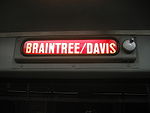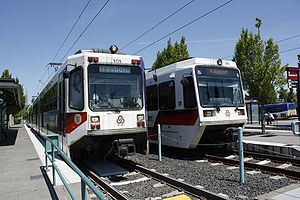
Destination sign
Encyclopedia


Public transport
Public transport is a shared passenger transportation service which is available for use by the general public, as distinct from modes such as taxicab, car pooling or hired buses which are not shared by strangers without private arrangement.Public transport modes include buses, trolleybuses, trams...
vehicle, such as a bus
Bus
A bus is a road vehicle designed to carry passengers. Buses can have a capacity as high as 300 passengers. The most common type of bus is the single-decker bus, with larger loads carried by double-decker buses and articulated buses, and smaller loads carried by midibuses and minibuses; coaches are...
, tram/streetcar
Tram
A tram is a passenger rail vehicle which runs on tracks along public urban streets and also sometimes on separate rights of way. It may also run between cities and/or towns , and/or partially grade separated even in the cities...
or light rail vehicle, that displays the vehicle's route number and destination, or the route's number and name on transit systems using route names. The main such sign, mounted on the front of the vehicle, usually located above (or at the top of) the windshield, is often called the headsign, most likely from the fact that these signs are located on the front, or head, end of the vehicle. Depending on the type of the sign, it might also display intermediate points on the current route, especially if the route is particularly long and its final terminus by itself is not very helpful in determining where the vehicle is going.
Technology types
Several different types of technology have been used for destination signs, from simple rigid placards held in place by a frame or clips, to rollsigns, to various types of computerized, electronicallyElectronics
Electronics is the branch of science, engineering and technology that deals with electrical circuits involving active electrical components such as vacuum tubes, transistors, diodes and integrated circuits, and associated passive interconnection technologies...
controlled signs, such as flip-disc
Flip-disc display
The flip-disc display is an electromechanical dot matrix display technology used for large outdoor signs, normally those that will be exposed to direct sunlight. Flip-disc technology has been used on buses across North America and Europe. It has also been used extensively on public information...
, LCD
Liquid crystal display
A liquid crystal display is a flat panel display, electronic visual display, or video display that uses the light modulating properties of liquid crystals . LCs do not emit light directly....
or LED
Light-emitting diode
A light-emitting diode is a semiconductor light source. LEDs are used as indicator lamps in many devices and are increasingly used for other lighting...
displays. All of these can still be found in use today, but most transit-vehicle destination signs now in use in North America and Europe are electronic signs. In the USA, the Americans with Disabilities Act of 1990
Americans with Disabilities Act of 1990
The Americans with Disabilities Act of 1990 is a law that was enacted by the U.S. Congress in 1990. It was signed into law on July 26, 1990, by President George H. W. Bush, and later amended with changes effective January 1, 2009....
specifies certain design criteria for transit-vehicle destination signs, such as maximum and minimum character height-to-width ratio and contrast level, to ensure the signs are sufficiently readable to visually impaired persons.
Rollsign

Crank (mechanism)
A crank is an arm attached at right angles to a rotating shaft by which reciprocating motion is imparted to or received from the shaft. It is used to change circular into reciprocating motion, or reciprocating into circular motion. The arm may be a bent portion of the shaft, or a separate arm...
or by holding a switch if the sign mechanism is motorized. Rollsigns were usually made of linen
Linen
Linen is a textile made from the fibers of the flax plant, Linum usitatissimum. Linen is labor-intensive to manufacture, but when it is made into garments, it is valued for its exceptional coolness and freshness in hot weather....
until Mylar (a type of PET film) became the most common material used for them, in the 1960s/70s. They can also be made of other material, such as Tyvek
Tyvek
Tyvek is a brand of flashspun high-density polyethylene fibers, a synthetic material; the name is a registered trademark of DuPont. The material is very strong; it is difficult to tear but can easily be cut with scissors or a knife...
.
Rollsigns are commonly seen in older public transport
Public transport
Public transport is a shared passenger transportation service which is available for use by the general public, as distinct from modes such as taxicab, car pooling or hired buses which are not shared by strangers without private arrangement.Public transport modes include buses, trolleybuses, trams...
vehicles, but are sometimes still used in modern vehicles. Since the 1980s, they have largely been supplanted by electronic signs,. A digital display may be somewhat less readable but has the advantage of being easier to change between routes/destinations and to update for changes to a transit system's route network. However, the long life of public transit vehicles and of the sign rolls, if well made, means that many transit systems continue to use these devices.
The roll is attached to metal tubes at the top and bottom, and flanges at the ends of the tubes are inserted into a mechanism which controls the rolling of the sign or blind. The upper and lower rollers are positioned sufficiently far apart to permit a complete "reading" (a destination or route name) to be displayed, and a strip light is fitted behind the blind, so as to illuminate it at night.

Crank (mechanism)
A crank is an arm attached at right angles to a rotating shaft by which reciprocating motion is imparted to or received from the shaft. It is used to change circular into reciprocating motion, or reciprocating into circular motion. The arm may be a bent portion of the shaft, or a separate arm...
—or holds a switch if the sign mechanism is motorized—which engages one roller to gather up the blind and disengages the other, until the desired blind display is found. A small viewing window in the back of the signbox (the compartment housing the sign mechanism) permits the driver to see an indication of what display is being shown on the vehicle's exterior.

Rapid transit
A rapid transit, underground, subway, elevated railway, metro or metropolitan railway system is an electric passenger railway in an urban area with a high capacity and frequency, and grade separation from other traffic. Rapid transit systems are typically located either in underground tunnels or on...
train or articulated tram can have several separate signboxes each—and only infrequently on buses, where it is comparatively easy for the driver to change the display. These signs are controlled by a computer through an interface in the driver's cabin. Barcode
Barcode
A barcode is an optical machine-readable representation of data, which shows data about the object to which it attaches. Originally barcodes represented data by varying the widths and spacings of parallel lines, and may be referred to as linear or 1 dimensional . Later they evolved into rectangles,...
s are printed on the reverse of the blind, and as the computer rolls the blind an optical sensor reads the barcodes until reaching the code for the requested display. The on-board computer is normally programmed with information on the order of the displays, and can be programmed using the non-volatile memory
Non-volatile memory
Non-volatile memory, nonvolatile memory, NVM or non-volatile storage, in the most basic sense, is computer memory that can retain the stored information even when not powered. Examples of non-volatile memory include read-only memory, flash memory, ferroelectric RAM, most types of magnetic computer...
should the blind/roll be changed. These sign systems are normally accurate; however, over time the blind becomes dirty and the computer may not be able to read the markings well, leading occasionally to incorrect displays. For buses, this disadvantage is outweighed by the need (compared to manual) to change each destination separately; if changing routes, this could be up to seven different blinds. Automatic-setting rollsigns are common on many light rail
Light rail
Light rail or light rail transit is a form of urban rail public transportation that generally has a lower capacity and lower speed than heavy rail and metro systems, but higher capacity and higher speed than traditional street-running tram systems...
and subway/metro systems in North America, and in the U.K. such capability is standard on the so-called "bendy buses" (articulated buses) of Transport for London
Transport for London
Transport for London is the local government body responsible for most aspects of the transport system in Greater London in England. Its role is to implement the transport strategy and to manage transport services across London...
(TfL) and in Citaro Gs, when equipped with blinds.
Flip-disc display
In the United States, the first electronic destination signs for buses were developed by Luminator in the mid-1970s and became available to transit operators in the late 1970s, but did not become common until the 1980s. These were flip-disc, or "flip-dot", displays.Flap display
Another technology that has been employed for destination signs is the split-flap displaySplit-flap display
A split-flap display, sometimes simply flap display, is a display device that presents alphanumeric text, and possibly fixed graphics, often used as a public transport timetable in some airports or railway stations, often called Solari boards, named after display manufacturer Solari di...
, or Solari display, but outside Italy this technology was never common for use in transit vehicles.
Electronic displays
Most present-day destination indicator signs consist of liquid crystal displayLiquid crystal display
A liquid crystal display is a flat panel display, electronic visual display, or video display that uses the light modulating properties of liquid crystals . LCs do not emit light directly....
(LCD) or light-emitting diode
Light-emitting diode
A light-emitting diode is a semiconductor light source. LEDs are used as indicator lamps in many devices and are increasingly used for other lighting...
(LED) panels that can show animated text, colors (in the case of LED signs), and a potentially unlimited number of routes (so long as they are programmed into the vehicle's computer). Some such signs also have the capability of changing on-the-fly as the vehicle moves along its route, with the help of GPS
Global Positioning System
The Global Positioning System is a space-based global navigation satellite system that provides location and time information in all weather, anywhere on or near the Earth, where there is an unobstructed line of sight to four or more GPS satellites...
technology and a vehicle tracking system
Vehicle tracking system
A vehicle tracking system combines the installation of an electronic device in a vehicle, or fleet of vehicles, with purpose-designed computer software at least at one operational base to enable the owner or a third party to track the vehicle's location, collecting data in the process from the...
.
External links
- East Anglian Bus Blinds (UK)
- U.K. Bus Blind Printers
- New York City SubwayNew York City SubwayThe New York City Subway is a rapid transit system owned by the City of New York and leased to the New York City Transit Authority, a subsidiary agency of the Metropolitan Transportation Authority and also known as MTA New York City Transit...
Rollsigns- JoeKorNer - Roll Signs (pre-1967)
- Rollsign Gallery (post-1967)

